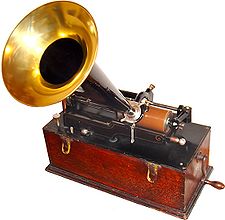Edison's Phonograph
Invented by Thomas Edison in 1877, the phonograph was made after Edison’s inventions of the telephone and telegraph. His purpose was to invent something that could ‘transcribe telegraphic messages through indentations on paper tape.’ Edison thought that messages could be recorded using the telephone in the same way. The indentations were created by the vibrations made while speaking. He later used metal instead of paper, for more effective results. The machine had two parts, one for recording and one for playing back the recording. Edison didn’t actually build the machine, though. Instead, he made a sketch of his idea and gave it to John Kreusi. Kreusi then built the phonograph within 30 hours. Edison was the first to test the machine by speaking ‘Mary had Little Lamb’ into the mouthpiece. Successfully, the machine played his words back.
The phonograph is an important contribution to media today because it is the basis of many other inventions. For example, record players, which used the same concepts to play back music as the phonograph did to play back one's voice. After the record player, came other forms of music systems, such as the cassette player, the CD player, and eventually the MP3 player.
The phonograph is an important contribution to media today because it is the basis of many other inventions. For example, record players, which used the same concepts to play back music as the phonograph did to play back one's voice. After the record player, came other forms of music systems, such as the cassette player, the CD player, and eventually the MP3 player.

